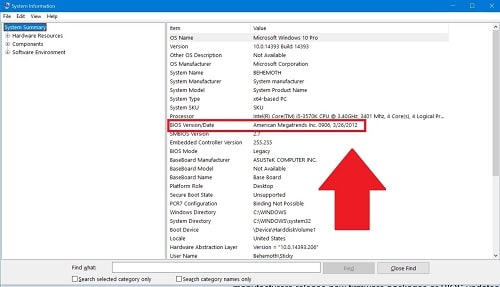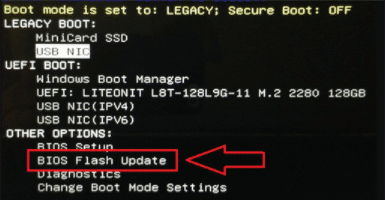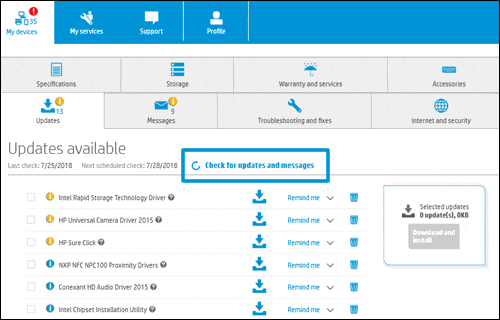This article will discuss the BIOS flashing process, which involves its downloading & installation procedures. Basically, BIOS stands for Basic Input Output System and is highly crucial to any computer system. It plays the primary role in the booting process & all other run-time services of the operating system. That’s why it is recommended to update the BIOS with the latest version consistently.
The BIOS update is essential for the system’s maintenance & better performance. An updated BIOS firmware will also improve the device’s compatibility with other hardware components.
HP BIOS update procedures
A wrong installation of BIOS can leave the worst effects on your system and can cause damage to its working. SO, suppose you use an HP device. In that case, we recommend installing the BIOS update on your system from HP’s official website only. Given this caution, the Support suggests the 3 most appropriate ways of updating the BIOS on your computer system.
Note: Don’t turn off or restart your computer system during the BIOS update process; otherwise, you may face worse results.
Manual update from within Windows

BIOS can be updated manually using the internet by few easy steps if performed in exact sequence. It is suggested to disable the antivirus software installed on your system before this update and close other running apps to evade any possible error. You can enable the antivirus again after completion of the HP update BIOS installation process.
Gather System Information
Before starting the proper installation, the first thing you need to do is to group together all the computer system information you may require during the update. It may include the exact device name, operating system version, processor name, ROM family SSID (motherboard ID), and pre-installed BIOS version.
To access all this information, you can use one of the Windows administrative tools, the “system information” app, which will summarize all kinds of system information; so, save this information for later use.
Install BIOS update HP
You can easily download the updated BIOS from HP’s official website.
- Navigate to the HP Support webpage. Please select a relevant BIOS from the list concerning your system information (device ID & pre-installed BIOS version) and check for its available updates. There is the possibility that you won’t get any BIOS update there. This is because you may already have an updated BIOS version installed on your HP computer.
- If you see many BIOS updates there, find the related one by matching your computer’s motherboard ID, which you got from the system information app. On finding a related BIOS update, click on the “download” option and then “save.”
- Open the location of the downloaded BIOS update and double click to launch it for installation.
- You will encounter a “User Account Control” prompt windows; click on “yes.”
- Complete the installation wizard by accepting all the stated terms & conditions and click on “next.”
- Select the “update” option then and click on “Next” again.
- Proceed on with the BIOS installation process by restarting the computer.
- Then click on the option “apply update now” available on the HP BIOS update screen.
- Then the computer will display the progress of BIOS installation, so continue select startup.
- The system will then automatically restart after finishing the whole process.
Manual update via USB flash drive

If you have lost your existing BIOS and related data, you would need to use another computer system with a good internet connection to carry on the “update BIOS HP” process. Then you can install this updated BIOS file to the targeted device by using a USB flash drive. For this flashing process, you may need to disable the antivirus software installed on your system temporarily.
This manual update using a USB flash drive will require the same information as needed for the update from within windows. So, similar to first, you need to gather similar information about your computer system such as operating system version, device name & number, process type, BIOS version, and system board ID (ROM family SSID).
Gather System Information
The process to gather this system information is slightly different in this kind of BIOS installation procedure. To access system information, turn on the targeted computer first.
- Then Instantly press the Esc (escape key) to launch the startup menu.
- In the startup menu, press F1 to access the “system information” window.
- Note down all the required system information from the system information summary on any notepad for later use.
Install BIOS update on USB flash drive
You can use an alternate computer system with internet connectivity to download the updated BIOS version on a USB flash drive to recover the BIOS on the first computer.
Note: The storage limit for the required USB flash drive is max. 1G.
- Attach a new or formatted USB flash drive to the computer.
- Navigate to the official HP Support webpage and search against the specific version of your computer device.
- You can select the BIOS option from the available list and check for its recent updates, if available.
- If the latest BIOS updates are available, then explore the one that is the best fit for your computer system requirements.
- To access the downloaded BIOS, open that particular folder where it gets downloaded and double click on the updated BIOS file to initiate its installation process.
- A “user account control” screen will be prompted; click on “yes.”
- An InstallShield wizard will start. Complete the wizard process by accepting all terms & conditions and following all the instructions.
- Then select the option “create recovery USB flash drive” in the last phase of the installation wizard and click on “next.”
- All the downloaded BIOS update files will get copied to the USB flash drive.
- After creating a successful copy of all the BIOS files, click on “finish” to end the wizard process and safely remove your USB flash drive then.
Update BIOS via USB flash drive
To update the BIOS on the targeted computer, attach your USB flash drive containing the updated BIOS file to the computer USB port, then follow the below stated steps.
- Turn on your targeted computer again and press Esc repeatedly to launch the “startup menu” window.
- In the startup menu, press F2 to open your computer’s system diagnostic.
- HP PC hardware diagnostics UEFI window be prompted, select your language here.
- Click on the “firmware management” option available in the next window.
- In the next step, click on the BIOS update option in the BIOS management screen.
- Click on the option “select BIOS image to apply.”
- In the following “select file system” screen, click on “HP_TOOLS-USB Drive.”
- Select the option “Hewlett-Packard” in the next prompted “file navigator” screen.
- Click on “BIOS” and procced on by selecting the “current” option.
- Select the BIOS updated version from 2 available version options.
- In the next window of BIOS management, click on “Apply update now.”
- The system may also require you to type an administrator password.
- You can easily see the installation progress displayed on the computer screen.
- When installation progress reaches 100%, you would need to click on the “restart system” option.
Automatic update via HP Support Assistant

HP device, either desktop or laptop, comes typically with pre-installed HP Support Assistant for automated supports & updates, which automatically updates the BIOS on the particular computer system. If your computer system does not have HP Support Assistant installed on it, you need to install it first from its official website.
To install the HPSA navigate to the HP Support Assistant website and click on Download “HP Support Assistant” button to download it on your computer.
- Click on the “My devices” tab in the HPSA tool to find out your device and then select the updates option.
- To explore the latest version of hp BIOS, click on the option “check for updates and messages.”
- The HPSA may take some time to fetch & display the results.
- If any new version of BIOS, advanced to the one you already have on your is available, click on the “BIOS update” option.
- Click on the “download and install” option to install the latest available version of BIOS on your HP device.
(You can also install any other update here if you require
- Close the HP support assistant tool when it finishes the BIOS installation process.
Conclusion
If you use an HP computer device, you may need to update its BIOS version either as a maintenance task or enhance system performance. HP presents different BIOS versions compatible with specific devices & operating systems. So, you need to ensure your entire system information before installing HP omen BIOS.
In the above discussion, we have stated the 3 authentic ways step by step to update BIOS on an HP Desktop or laptop. You can go for the feasible & quick option of automatic update through HP Support Assistant if HPSP is already installed on your device. The other 2 ways involve manual BIOS update from within windows & via USB flash drive.
Read Also
- HP Envy 5055 All In One Printer Review
- How To Fix Printer Driver is Unavailable Error
- How to Fix ERR_INTERNET_DISCONNECTED
- How to Fix “Windows Smartscreen Can’t Be Reached” Error
- How to Fix Windows 10 Audio Services Not Responding Issue?
- How to Change Your Account Name on Windows 10
- What Is Realtek Card Reader Software?
- Dell Inspiron 15 7000 2-in-1 Black Edition (7506) review

